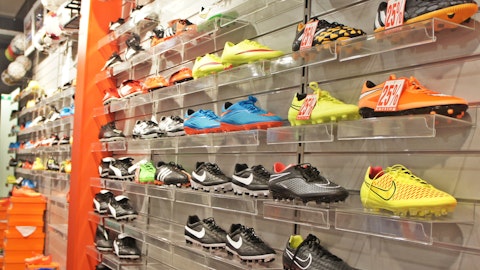We came across a bearish thesis on Skechers U.S.A., Inc. (SKX) on wallstreetbets Subreddit Page by Traditional-Year3847. In this article, we will summarize the bears’ thesis on SKX. Skechers U.S.A., Inc. (SKX)’s share was trading at $50.49 as of April 24th. SKX’s trailing and forward P/E were 12.14 and 12.21 respectively according to Yahoo Finance.

andersphoto / Shutterstock.com
Skechers’ Q1 2025 results underscore significant cracks in the company’s business model, validating the bearish thesis centered on tariff vulnerability and margin compression. Despite a strong topline growth of 7.1%, the company’s operating income fell by 11.3%, signaling the challenges it faces in maintaining profitability amid rising costs. This divergence between revenue growth and profit decline points to a deeper issue: Skechers is struggling to maintain its margins, a key factor in the bearish outlook for the company.
The most notable confirmation of the bearish thesis comes from Skechers’ decision to withdraw its full-year guidance, citing “macroeconomic uncertainty stemming from global trade policies.” This move directly supports the earlier prediction that Skechers’ reliance on Asian manufacturing makes the company highly vulnerable to tariff impacts, particularly the 125% tariffs that are set to escalate in the coming quarters. This tariff risk looms large, as Skechers lacks the pricing power to absorb these costs without eroding demand or margins.
Skechers’ significant exposure to the Chinese market exacerbates its challenges. Sales in China dropped by 15.9% year-over-year, representing the company’s worst-performing region. This sharp decline further supports the bearish thesis, highlighting the intensifying competition within China and the company’s waning market share. The fact that management attempted to reframe the performance by excluding China from its regional results only underscores how critical this market has become for the company’s global strategy. China, once accounting for 14.2% of total sales in Q1 2024, now represents just 11.1%, confirming that the company is losing ground in one of its most important markets. The combination of lower demand and rising tariffs creates a precarious situation for Skechers, where both its sales and profit growth are under significant pressure.
The margin story is particularly concerning. Operating margins fell by 230 basis points to 11.0%, and gross margins dropped by 50 basis points to 52.0%. Operating expenses increased by 12.1%, far outpacing the 7.1% revenue growth. This compression in margins occurred before the full impact of the increased tariffs hits in Q2 and beyond, further emphasizing Skechers’ inability to offset rising costs through price hikes. The company’s pricing power is clearly lacking, and its inability to protect its margins from cost pressures reveals a fundamental weakness in its business model.
Skechers’ inventory situation also presents a risk. Though inventory levels decreased by 7.6% from December 2024, they remain historically high at $1.77 billion. The risk here is that, as tariff-related costs continue to flow through the supply chain, Skechers may face margin-eroding markdowns or increased inventory buildup. This could further strain profitability and exacerbate the challenges facing the company.
In light of these results, the bearish thesis remains intact, with Skechers facing substantial downside risks. While the company has seen strong revenue growth, it has struggled to convert that growth into profits. The withdrawn guidance, coupled with the continued weakness in China and deteriorating margins, strongly suggests that the company’s business model is ill-equipped to withstand the tariff pressures. The company’s position in China, its reliance on low-cost manufacturing, and its inability to pass through tariff-related cost increases without hurting demand are all signs of deeper structural issues that will likely continue to weigh on the stock.
Given these dynamics, the stock’s decline from $73 to $50 already reflects some of the challenges, but the Q1 results suggest that more downside is likely. The original bearish price target of $24.80 to $32 remains firmly in play, as the full impact of tariffs and margin pressure is yet to be fully realized. Skechers’ inability to pass through cost increases and its dependence on China’s market, which is showing signs of weakness, make it particularly vulnerable to further market repricing.
Investors should be prepared for continued slow-motion repricing of the stock. While the company may not be facing a sudden collapse, the combination of escalating tariffs, continued margin compression, and an inability to navigate these macroeconomic headwinds suggests that the stock has further room to fall.
Skechers U.S.A., Inc. (SKX) is not on our list of the 30 Most Popular Stocks Among Hedge Funds. As per our database, 45 hedge fund portfolios held SKX at the end of the fourth quarter which was 42 in the previous quarter. While we acknowledge the risk and potential of SKX as an investment, our conviction lies in the belief that some AI stocks hold greater promise for delivering higher returns, and doing so within a shorter timeframe. If you are looking for an AI stock that is more promising than SKX but that trades at less than 5 times its earnings, check out our report about the cheapest AI stock.
READ NEXT: 8 Best Wide Moat Stocks to Buy Now and 30 Most Important AI Stocks According to BlackRock.
Disclosure: None. This article was originally published at Insider Monkey.




